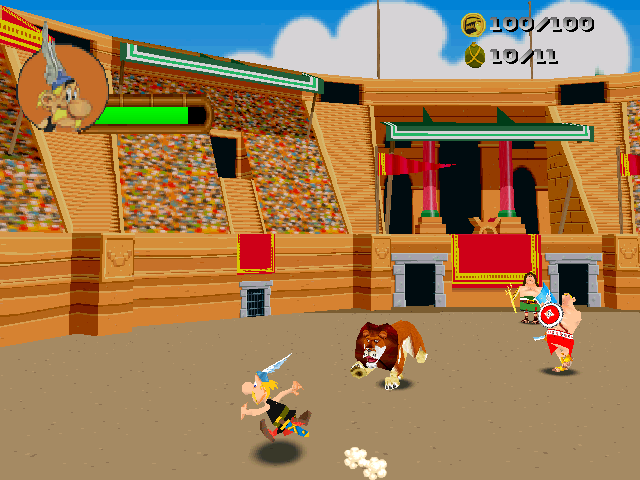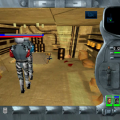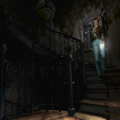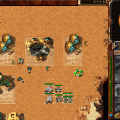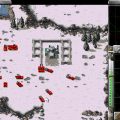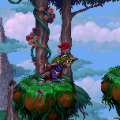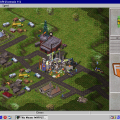- Asterix (Introduction)
- Astérix / Taz (Atari 2600)
- Obelix
- Asterix and the Magic Potion
- Asterix and Obelix: The Odyssey
- Asterix and the Magic Cauldron
- Asterix at Rahàzade
- Asterix: Operation Getafix
- Astérix (Arcade)
- Astérix (SMS)
- Astérix (NES/GB/SNES)
- Astérix and the Great Rescue
- Astérix and The Secret Mission
- Astérix and the Power of Gods
- Asterix: Caesar’s Challenge
- Astérix & Obélix: Die Suche nach dem Schwarzen Gold
- Astérix & Obélix Take on Caesar
- Astérix: Search for Dogmatix
- Astérix: The Gallic Wars
- Astérix Mega-Madness
- Asterix & Obélix Bash Them All
- Astérix & Obélix
- Astérix & Obélix XXL
- Astérix & Obélix XXL 2
- Astérix at the Olympic Games
- Astérix & Obélix Encounter Cleopatra
- Astérix: These Romans Are Crazy!
- Astérix: Rescue Obélix / Astérix and the Vikings / Astérix and Cleopatra
With the massive hype and anticipation set for the release of the live-action Astérix movie, Infogrames decided it was a good time to develop a new game of their own to be released around the same time that the movie would take the continent by storm. Infogrames held (and still does to this very day) the license to the comic book likeness of Astérix to be used in video games, so it was an excellent opportunity for them to make something different. They looked into their own library of past titles and eventually found one particular game that could use an update and a new take. The name of the game this time, is war.
Astérix: La Bataille Des Gaules (Astérix: The Gallic Wars) is a reimagining of Infogrames’s classic title North & South, released on home computers and consoles in 1989. It was itself based on a Belgian comic book by Willy Lambillotte and Raoul Cauvin called Les Tuniques Bleues and shared many similarities with Astérix. They both featured a backdrop of war, in this case the American Civil War, and dealt with this topic with humor, social satire and parodies mixed with accurate history, though sometimes altered to fit storylines. The comic book of Les Tuniques Bleues would not have much impact outside of its own territory (the first true widespread English release came in 2008, under the name The Bluecoats) but the game it spawned would become a worldwide hit. North & South was a lighthearted war strategy game where you could play as either The North or The South with the ability for you to change the historic outcome, a feature which surely warmed the hearts of several rednecks. Astérix: The Gallic Wars plays very similar to this board game interface, though also relies on more elements seen in Risk to flesh out the game more.
There is no choice of what side you will take, here you fight for the Gauls to take back their country. The game takes place on a simplified map which includes several keypoints of the Roman Empire. As you start the game you will notice several things. In the Gaul village, you see a big cauldron with a number on it, and surrounding it are Roman camps which also display a number as the pointer hovers over it. These numbers indicate how many troopers are stationed in that section. The higher the number, the bigger the cauldron or camp. The goal of the game is to retrieve seven ingredients for Panoramix’s new secret potion. The ingredients he needs include a branch of mistletoe, a Roman standard, an amphora of wine, an edelweiss flower, a baby menhir, pirate gold and bath salts. I wonder if bringing these items together through customs today would cause any suspicion? Once you get a good look at the map and map out your strategy, it’s time for warfare. There are three actions to take on the map screen, all represented by a character:
Panoramix will be able to fill up the Gaul camps with more troopers to strengthen whatever territory you may wish, as long as it is in clear reach. If Roman camps surround a Gaul cauldron, you cannot deploy any troops to it unless you open up a trail for it by removing whatever Roman camp that stands in your way. Obélix takes charge of the battle and leads the troops to war. You have three turns to engage in battle, and you initiate this by clicking a cauldron. With each click you enlist a troop to your army (one must be left behind to guard the territory). You then choose what camp to attack and watch the battle unfold, which is displayed on the map by a bodies flying everywhere and leaving a cloud of dust behind very much in the spirit of Astérix comics. You can only attack camps that are in direct reach to the border of the territory you choose. Astérix takes care of the reinforcements and gives you 3 turns to send troops to neighboring Gaul camps to strengthen them after battles. After your set of actions are done, it is the Roman’s turn, and they have the same number of turns and actions as you do. While most territories will simply display a battle animation lasting five seconds, certain parts of the map will trigger an event. The first of these events to note are the mini-games.
The mini-games allow you to take over the land by simply accomplishing the task given to you before the start of the round. There are 4 different ones to encounter altogether with these being Whack-A-Roman, Barrel Break, Bowl-A-Roman and Throw-A-Roman.
Encountering these mini-games bypasses the battle completely in favor of you accomplishing to achieve the required point minimum. If you win, you gain some extra troops as a bonus. If you lose, you get nothing at all. Depending on the number of troops you send to begin with, you get extra amount of time based on the strength of your invading army.
The other events you trigger are the key points to this game. Like in North & South, landing on certain spots will toss you in an interactive level where you infiltrate the area and search for the ingredient that the locations holds. The first one you will encounter is Carnac, the menhir field near the Gaul village. Here you play as Obélix as he straddles along the grass fields beating up Roman soldiers. You’ll see two counters near your life bar, one for a cauldron and the other for coins. There are always 100 coins to find and five cauldrons which, if you find them all, will give you a healthy bonus if you beat the level. These scenes makes use of three buttons – Attack, Run and Jump. The camera is fixed at a side view position and you have to navigate your way through the fields avoiding boulders, jumping over pits and finding hidden cauldrons and rooms. When there’s any battle, the scrolling stops until you beat the incoming batch of enemies. The ingredient is always found at the end of the level. These seven locations are quite varied and you will either be assigned Astérix or Obélix depending on where you are. The places you visit include the Gaul forest, the hometown of the pirates, the French alps and a Roman bathhouse. Each section you can explore look unique and the level design is well done and varied between them. When you beat these stages and acquire the item, you will gain one extra troop to deploy, while the Romans lose one. Once all these items are found, you unlock the two last levels, a pirate ship and Rome.
The graphics are also quite well done. The map screen uses simple 2D sprites and the color palette look near identical to that used in the comics. During the exploration sections and mini-games, the game changes to 3D graphics, which uses an early attempt at cel-shaded style graphics. The models and details in the 3D sections can look a bit cheap in extreme closeups, but at the distance the camera is usually positioned, they look fine and instantly recognizable. There’s also some exclusive animation drawn specifically for this game, done by Praxinos, who were also responsible for the animation on Wild Instinct, the cartoon about zoo animals who hide their intelligence from the guests at the zoo. These animations look great though heavily compressed in order to properly fit on the disc. These animations are only narrated and features no character voice overs.

The music though, is the absolute best part of the entire game, which will take players completely off guard. Composed by the duo of Doug Boyes and Dave Boardman under the pseudonym 2dB. A mixture of Celtic music and cinematic epics, the soundtrack includes the quirky lighthearted melodies that one would see fit Astérix along with some epic passages with a sequenced orchestra using some very high end samples. Throw some jazz into mix and you know you’ve got yourself a great score. It can even be argued if the soundtrack is so good that it makes the game worth it alone. 2dB would go on to do soundtracks for numerous games, most notably Hogs of War and Looney Toons: Space Race, but nothing would touch their work on this particular title. The sound effects don’t hold up as well, with most of them being stock effects and the voice effects sounds like seniors having heart attacks for the most part.
A number of issues keeps this title from being as great as it could have been. While the map is of a good size, it doesn’t really offer enough to keep your interest for very long. The interactive sections offer some change, but with only two forces fighting eachother, you essentially just sit and wait for your turn and don’t see much change to the map after the Romans are done. The battles on the map also can be frustrating. The outcome is randomly determined by the CPU and it can be cheap unlike any other. If, for instance, you send 10 troops into a camp of 1 Roman, there’s nothing keeping that 1 guy taking out 5-6 guys out of your army. Likewise if you send 1 Gaul into a camp of 10 Romans, there’s actually a slight chance you will beat them all. This can cause some frustrating losses, and when you lose one of the key territories, you have to replay the level to take it back, leading to a lot of replays. The mini-games can also lead to some cheapness both ways. Especially frustrating out of these is the Bowl-A-Roman game. Here, you have by default 1 minute to reach 30 points, Romans will pass with the maximum combo being 3. However Idéfix will at times pop up and if you hit him, it’ll cost you a point. The Romans never sync up and lots of time is wasted waiting for chances to score points, leading you to lose. I had to send an army of 20 to this game in order to get another minute or so at my disposal to reach 30, and even then, I was near defeat. Equally frustrating are some of the jumps in the platforming sections. Because of the fixed camera, you often have to perform jumps inwards the screen, making it difficult to navigate where you will land and the distance you must travel. There are only a few of these that include deadly pits at least.
Despite some issues, it’s still a fine game and a fresh take on Astérix. The gameplay works well for the story and it’s challenging enough that both kids and veteran players can find some fun, though it’s questionable if the fun holds up after several playthroughs. When first released on PlayStation, the game was only named Astérix, but in order to differentiate it from other games, it was given the added subtitle of The Gallic Wars when released on PC a few months later. The PC version is a direct port of the PSX version and even includes a lot of leftover graphics such as the PlayStation control icons. It supports the higher resolution of 640×480 compared to PSX’s 320×320. There aren’t any real changes made, other than slightly sped up Roman turns, as they removed the sequence of Roman deployment and only show the attacks. An added bonus on the PC version though is the inclusion of a lossless soundtrack. On the disc you will find wav files of the entire soundtrack, sounding much more powerful and clear than it does on PSX. If you can find it cheap, the PC version is worth getting just to have the soundtrack in its full quality and glory.
